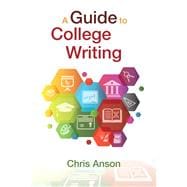For courses in first-year composition and rhetoric.
A refreshing new choice that addresses writing in all college-level courses
A Guide to College Writing is both an excellent introduction to college writing for composition courses that emphasize writing across the curriculum (WAC), and a writing guide for use in any college course. The text does not teach any one form, but rather how to observe, analyze, and reproduce the forms and intellectual strategies of whatever the students might be asked to read and write. Students are walked through the writing process, beginning with shorter, lower-stakes “microtheme” assignments and scaffolding toward longer, sustained formal projects typical of their discipline. Throughout, students learn how to use writing as a learning tool.
Also available with Pearson Writer
Pearson Writer is a revolutionary digital tool for writers at all levels. Built for mobile devices, it streamlines the tedious and time-consuming aspects of writing, so that students can focus on developing their ideas.
Pearson Writer makes it easy to stay organized, track tasks, and stay on top of writing projects. Students can set milestones prior to the due date, manage their sources, organize their notes visually in the Notebook, and even get automatic feedback on their prose. Pearson Writer is now available with Noteclipper, which allows students to save online sources quickly and easily.
Note: You are purchasing a standalone product; Pearson Writer does not come packaged with this content. Students, if interested in purchasing this title with Pearson Writer, ask your instructor for the correct package ISBN and Course ID. Instructors, contact your Pearson representative for more information.
If you would like to purchase both the physical text and Pearson Writer, search for:
0134266439 / 9780134266435 A Guide to Writing in College Plus Pearson Writer — Access Card Package
Package consists of:
- 0134186443 / 9780134186443 A Guide to Writing in College
- 032197235X / 9780321972354 Pearson Writer — Valuepack Access Card








